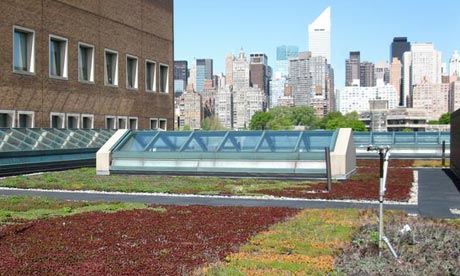Green roofs offer antidote to urban heat island effect, say researchers
Researchers at Columbia University have demonstrated that a layer of plants and earth can cut the rate of heat absorption through the roof of a building in summer by 84%
Green roofs, like the one pictured above, benefit more than just their owners, according to Stuart Gaffin, a researcher at Columbia University. "They are a win-win on so many fronts," he said.
Perhaps the greatest overall benefit of green roofs comes in tackling the "urban heat island" effect, which Gaffin suggests is responsible for two-thirds of New York's localized warming over the last century. The conventional black rooftops that he calls "tar beaches" are major contributors to this phenomenon, absorbing and re-radiating the sun's energy as heat. "We're going to want to cool regional climate down, especially where people are living," Gaffin noted. "So we're going to have to confront the urban heat island effect."
While conventional roofs can reach temperatures of 80 °C at 1.00 p.m. even outside of high summer, green roofs always stay closer to ambient temperatures. "These [conventional roofs] are almost dangerously hot spaces," Gaffin told environmentalresearchweb. "That's a huge heat load that we can get rid of."
Plants in green roofs regulate their temperatures through evapotranspiration. "They evaporate copious amounts of water," Gaffin explained. "That takes a lot of energy and means it's a great way to stay cool." Eliminating extreme temperature cycles allows green roofs to be designed as relatively low maintenance options. They experience less thermal expansion and contraction stress, leading to predictions of at least a doubling of lifespan compared to black roofs.
The urban heat island effect is often used by critics of climate research to suggest that measured temperature rises don't indicate global warming. "Generally the climate research community avoids even using urban weather stations, or attempts to make corrections, because you know that's a warming bias," Gaffin explained.
The Columbia team is considering whether meteorological stations on green roofs might provide improved measurements for urban studies, however – although even this wouldn't enable them to assess climate change. The US National Weather Service recommends placing sensors at least 100 feet from paved or concrete surfaces. "One of the major restrictions says 'don't put them near black asphalt rooftops'," Gaffin explained. "When you put green roofs up, they are like meadows in the sky."
White is another roof colour used to fight both the urban heat island effect and global warming in general, by simply reflecting light back into space. This offers cheaper installation than green roofs, but needs special maintenance to prevent dirt reducing its effectiveness. Together, Gaffin expects green and white to replace black roofs. "I think the way we're going to cool things down in cities is going to be a combination of vegetation and brighter surfaces," Gaffin said. "There's going to be a contribution from both."








No comments:
Post a Comment